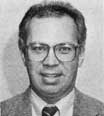 |
Home | Search | Browse | About IPO | Staff | Links |
 |
Home | Search | Browse | About IPO | Staff | Links |

New Direction For Bridge Inspection
By WILLIAM T. SUNLEY, Engineer of Local Roads and Streets Illinois Department of Transportation
The state of the nation's bridges has been a topic that has aroused much discussion and debate for at least two centuries. In bygone years the interest had to do with marvel at such spectacular accomplishments as the Brooklyn Bridge, the Golden Gate Bridge and countless others. Appropriately, their creators were held in the highest public esteem. Much of the former glory surrounding these engineering marvels has given way to a more alarmed, "How are we going to keep these rusting hulks from falling down on our heads?" These great structures as well as tens of thousands of smaller ones are getting old. Bridges and culverts in Illinois are no strangers to the nationwide problem. Today's structures reflect the technical advances in design, construction and safety that have evolved over the years. In the past 10 years about 4400 new bridges have been built on the Illinois local road system. However, many structures serving our highways were built in excess of 50 years ago. It has been generally accepted among bridge engineers that the useful life of a bridge is normally about 50 years. In spite of the technological advances made over the years, the condition and adequacy of Illinois bridges, as they relate to the overall highway network, demand close scrutiny and continual attention. A key ingredient in keeping up with bridge needs is a good system of inventory and inspection. To this end the National Bridge Inspection Standards (NBIS) were mandated by Congress in 1968. Illinois has used these standards as a basis for its own bridge inventory and inspection program now called the Illinois Structure Information System (ISIS) since 1970. All structures spanning openings greater than 20 feet and open to general use by the public are included in the inventory and require biennial maintenance inspections. We recognized the need to modify the former structure information system to better address developing needs. Taking advantage of more sophisticated computer capabilities, the Department set out to redesign this data file to enhance the update process and to include additional data items to meet increasing information needs. This effort was initiated in 1986 and completed in May, 1988. Meanwhile, the Federal Highway Administration extensively revised its Recording and Coding Guide for the Structure Inventory and Appraisal of the Nation's Bridges in 1988 and required compliance by January 1, 1990. STRUCTURE INFORMATION AND PROCEDURE MANUAL With so many changes occurring so rapidly in the inventory and inspection of State and local bridges, the familiar Local Roads and Streets Bridge Inspection Procedures Manual, which had been used since 1971, was rapidly becoming obsolete. Work on a new manual, which came to be titled the Structure Information and Procedure (SIP) Manual, began in the Spring of 1989. It was to provide documentation for the ISIS and the related IDOT Maintenance Management Information System (MMIS) as well as direction for bridge inspection procedures and coding. The major changes in the inventory, inspection and coding procedures made rapid development of a new manual of paramount importance if the integrity of the ISIS was to be maintained. Credits to: Timothy E. Souther, Local Roads Bridge Operations Engineer. December 1990 / Illinois Municipal Review / Page 9 A team of individuals was organized within the Department of Transportation from the Office of Planning and Programming and Bureaus of Bridges and Structures, Local Roads and Streets, Maintenance, and Traffic to accomplish this. Development was complicated by the concurrent incorporation of the 1988 Federal coding requirements which had to be in place by the end of the year so that each effort had to be carefully coordinated with the other. This and other obstacles were overcome allowing the new manual to be released in March of 1990. As development of the manual progressed, not only were the federally mandated changes addressed but the opportunity was taken to improve on perceived shortcomings of the Bridge Inspection Procedures Manual. The development team decided that the new manual should provide a clear view of all aspects of the Illinois bridge inventory and inspection system. General organization of the SIP Manual is similar to its predecessor but with greatly expanded system and item descriptions and much clearer coding directions. The instructions within the manual create an objective basis for judging structural condition during inspections. These instructions are based on guidelines being taught in the IDOT "Bridge Inspector's Training Course". It is hoped that this will result in a more accurate picture of the deficiencies of Illinois bridges than was previously possible. This will provide an improved tool for planning and programming bridge replacements and rehabilitations and for communicating the need for such work in a more understandable and confident manner. The new Structure Information and Procedure Manual provides an essential link between the field activities performed by the responsible agencies and the computerized database containing Illinois' highway structure information. It is expected that revisions and improvements will be made periodically based on suggestions from the users. Local agency users are encouraged to provide constructive criticism which should be directed through the respective IDOT District Bureau of Local Roads and Streets or the Local Roads and Streets Bridge Unit. With mutual cooperation the SIP Manual can be effective in the continuing effort to protect our investment in bridges and insure the safety of the public. Page 10 / Illinois Municipal Review / December 1990 |
|
|